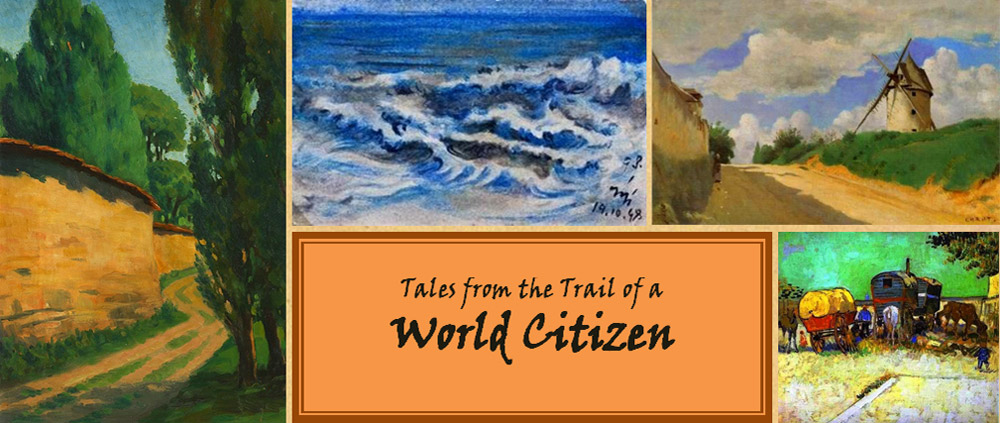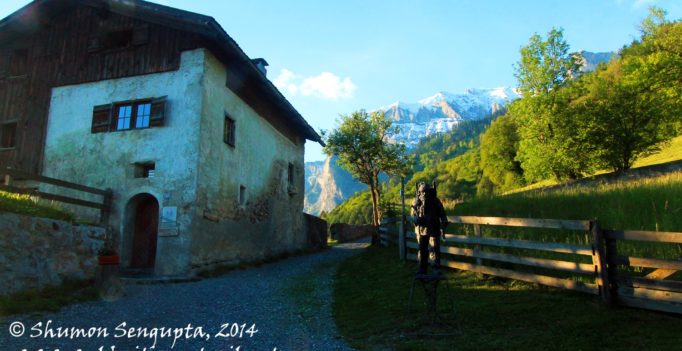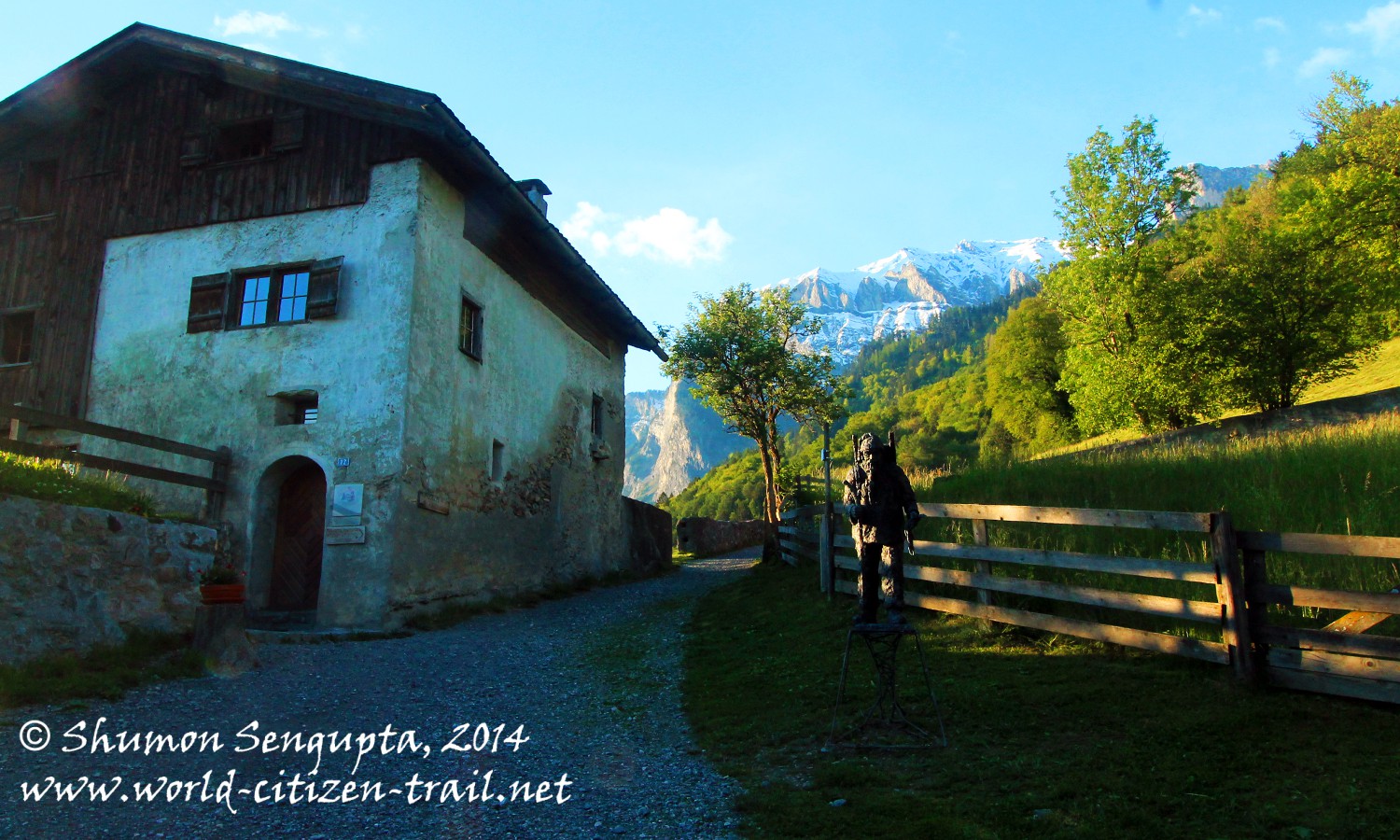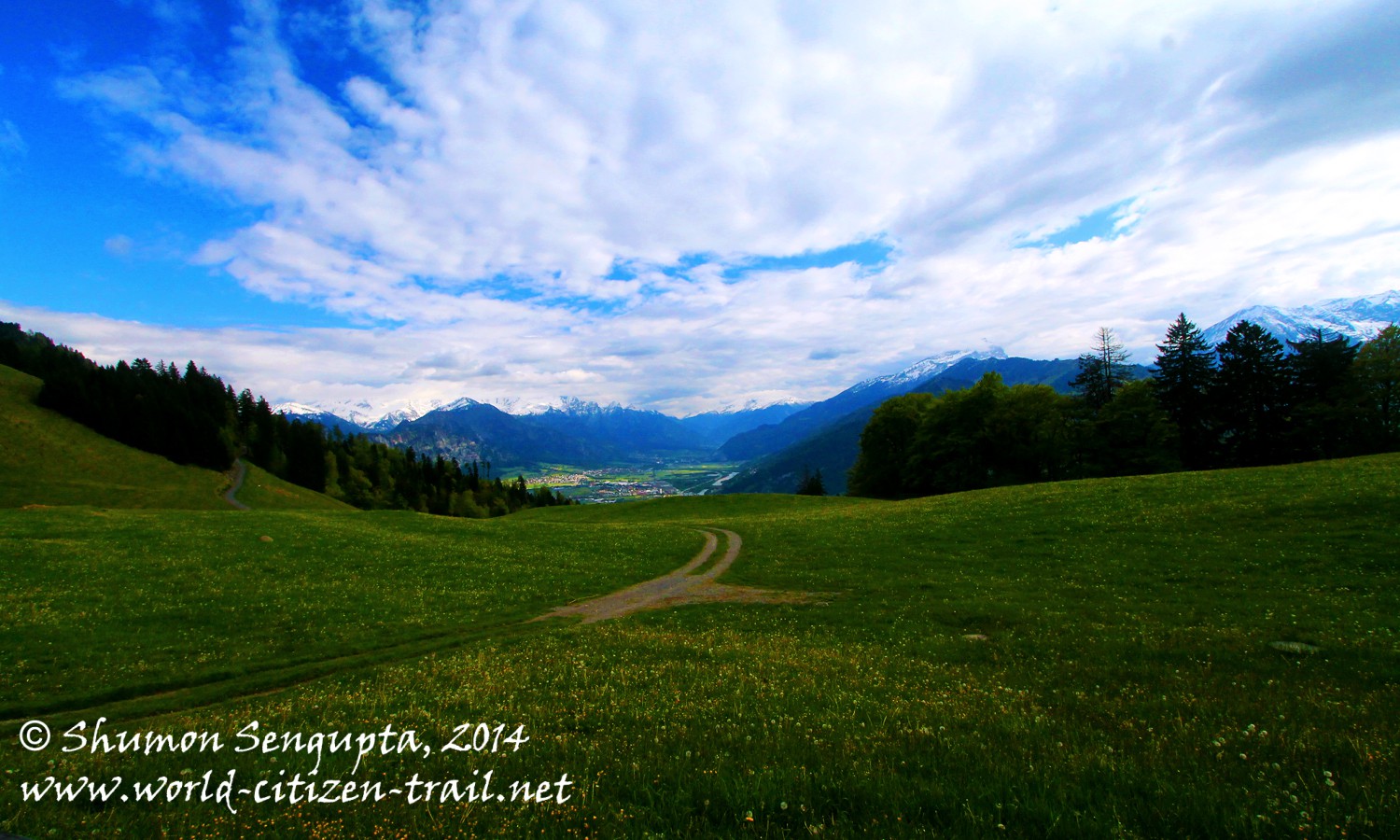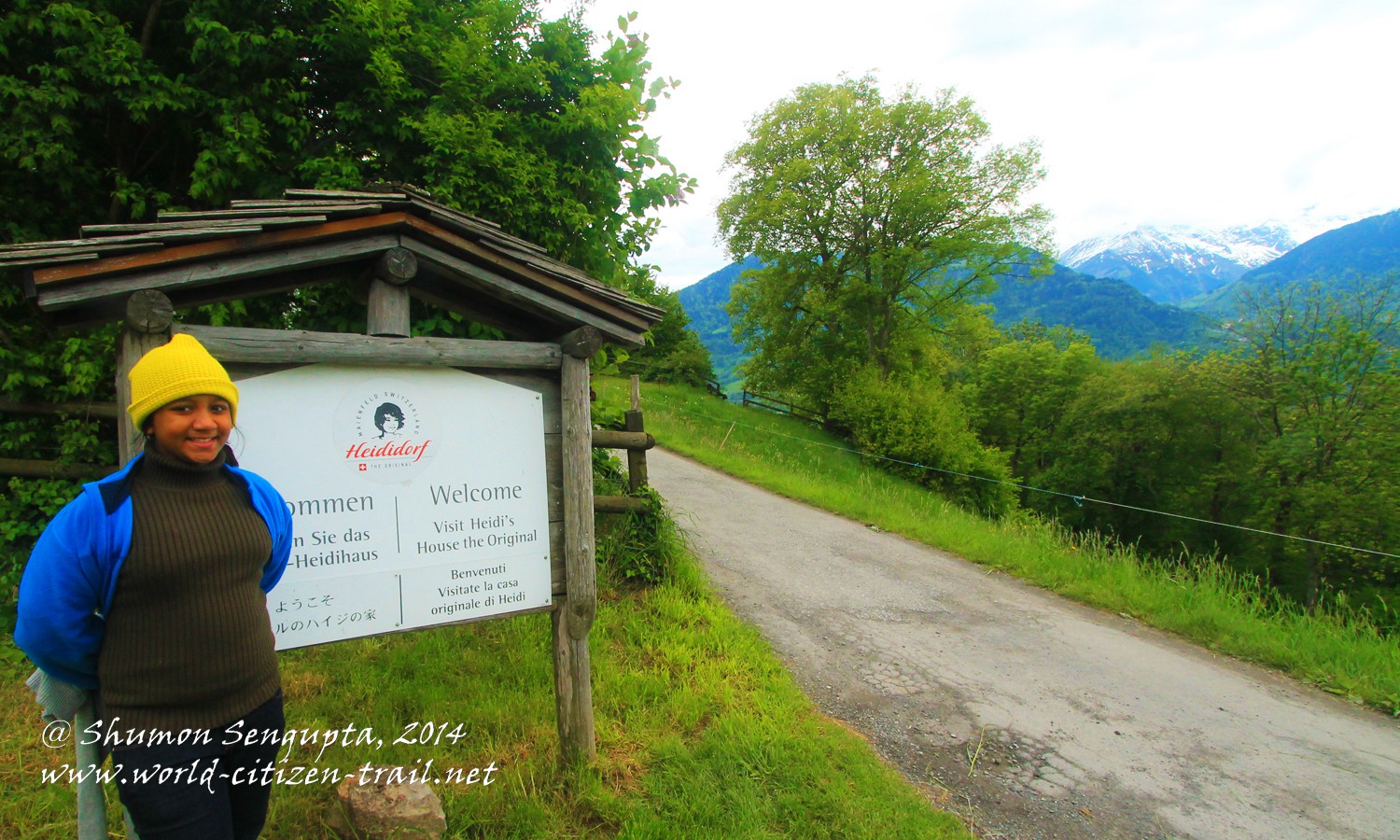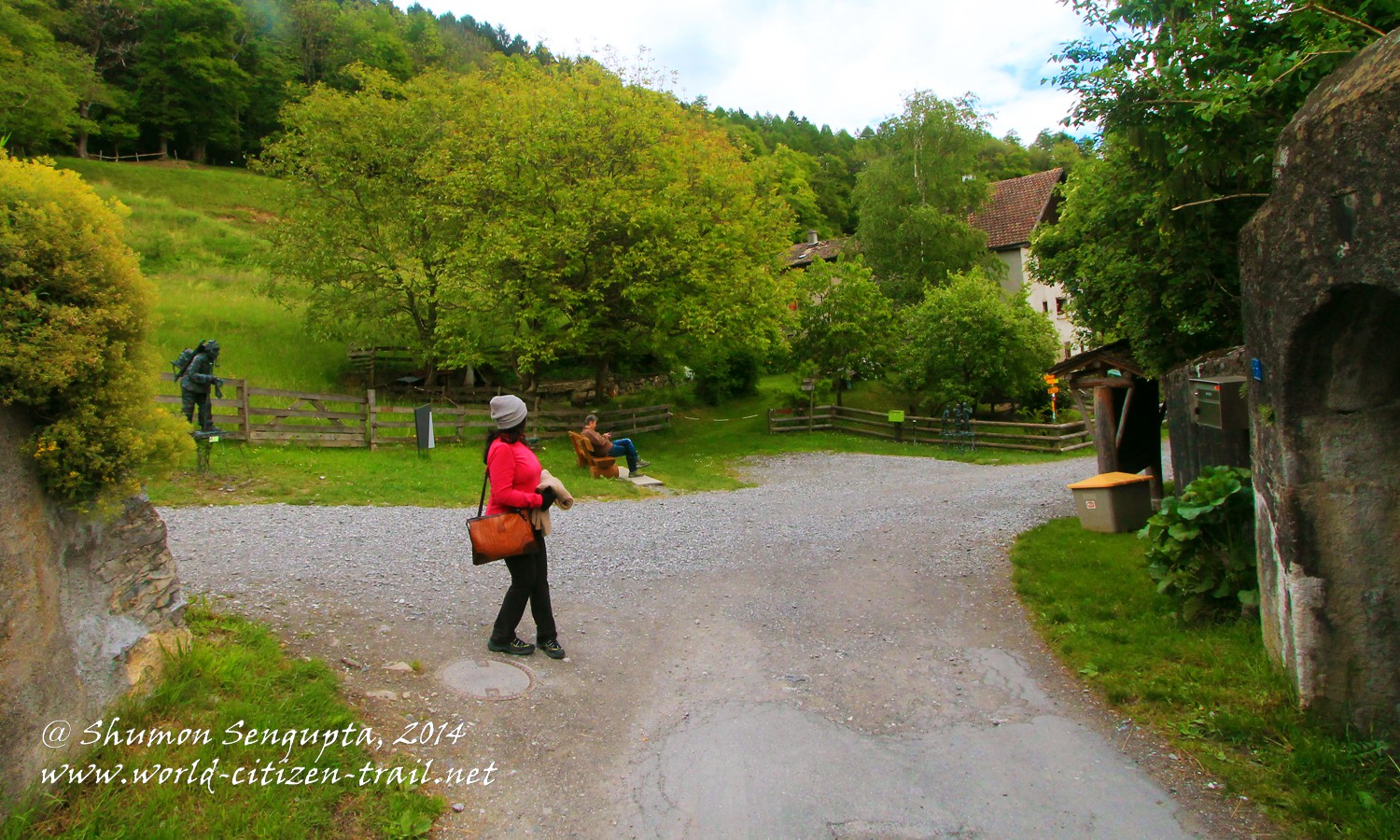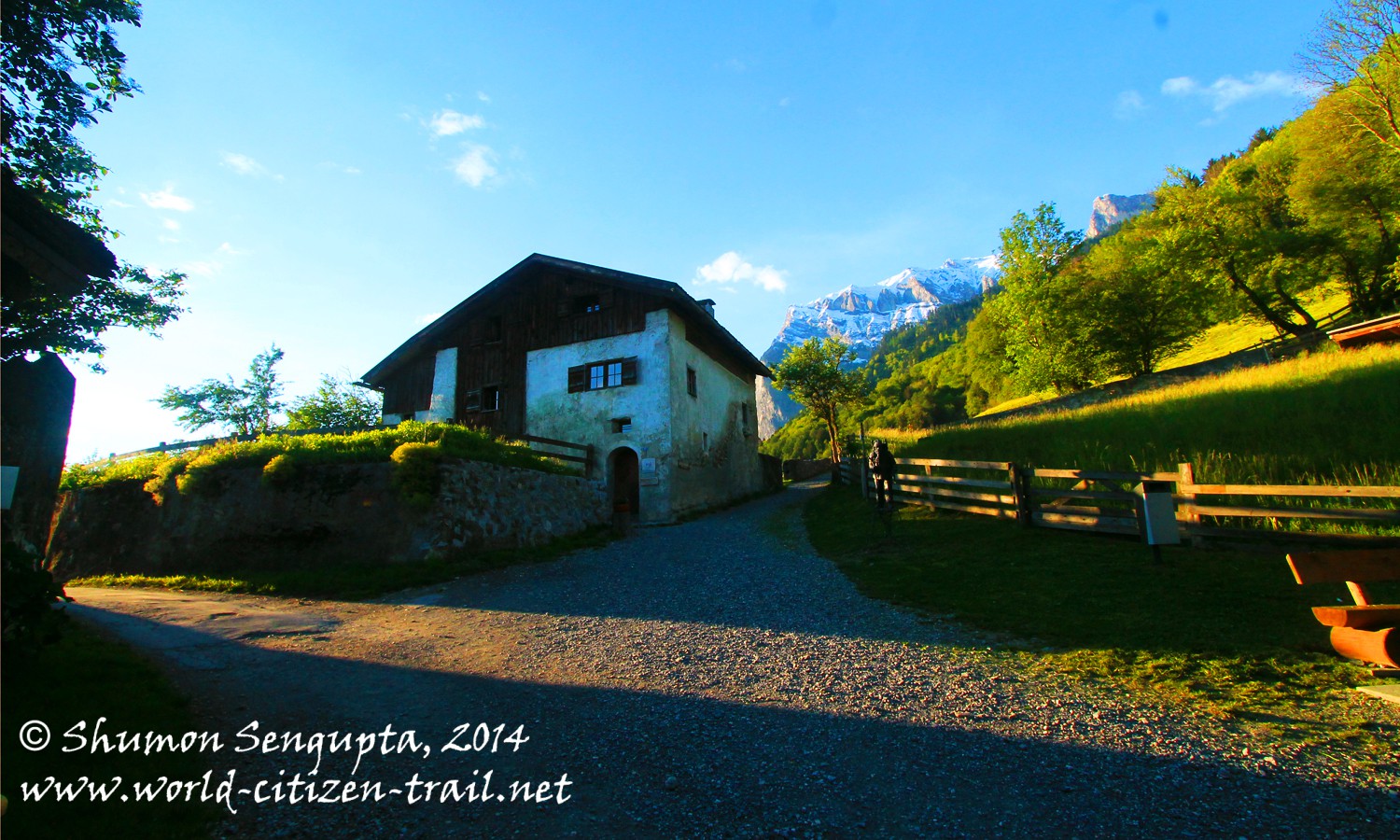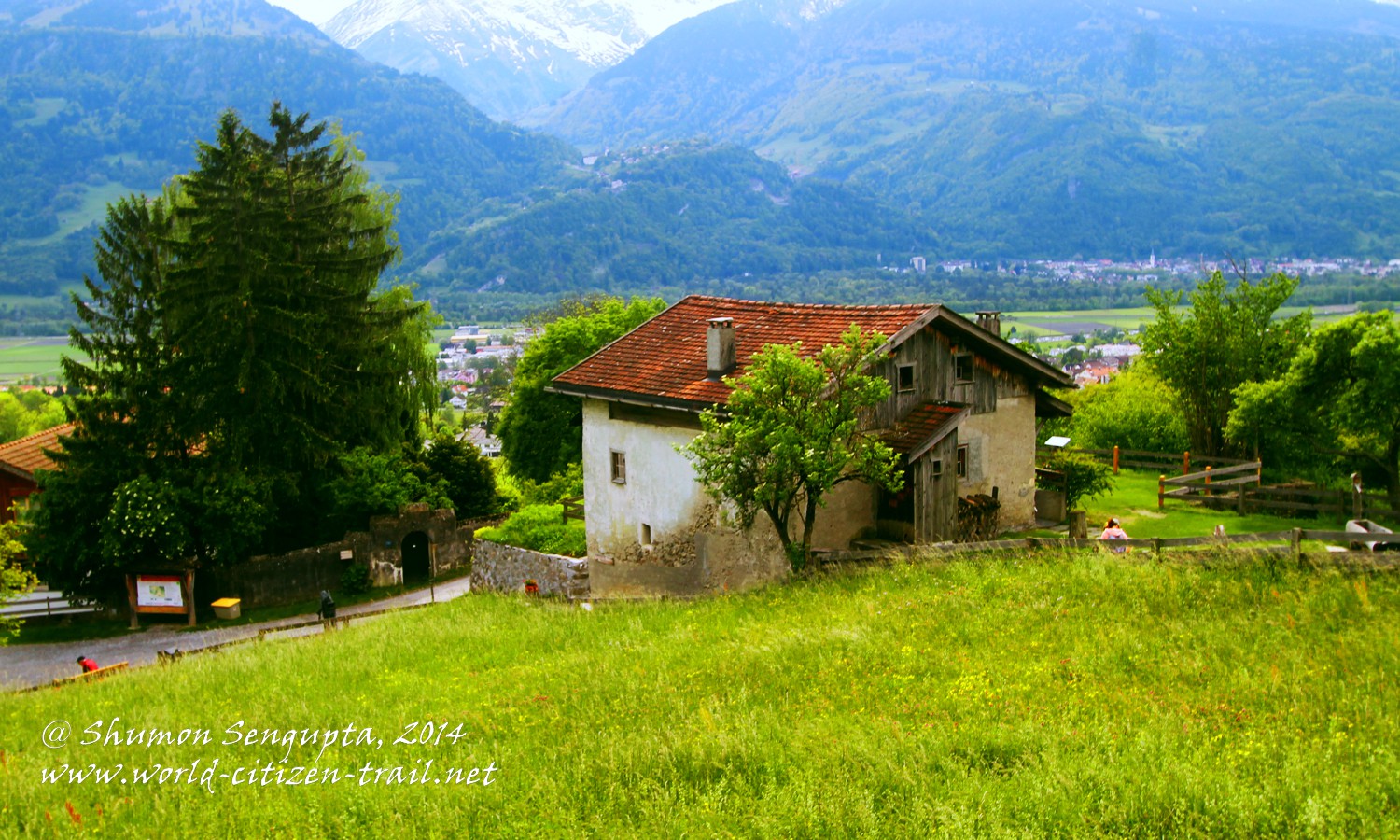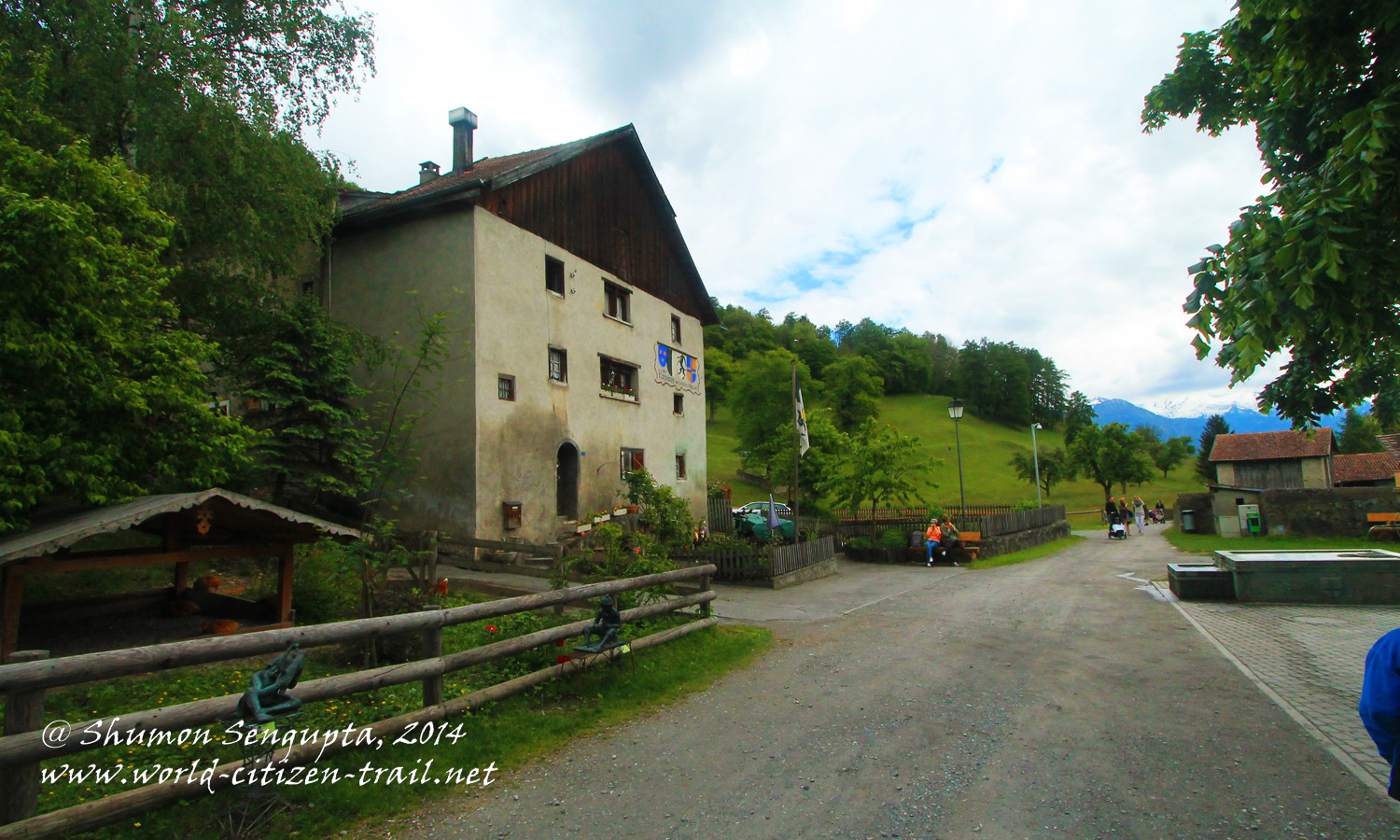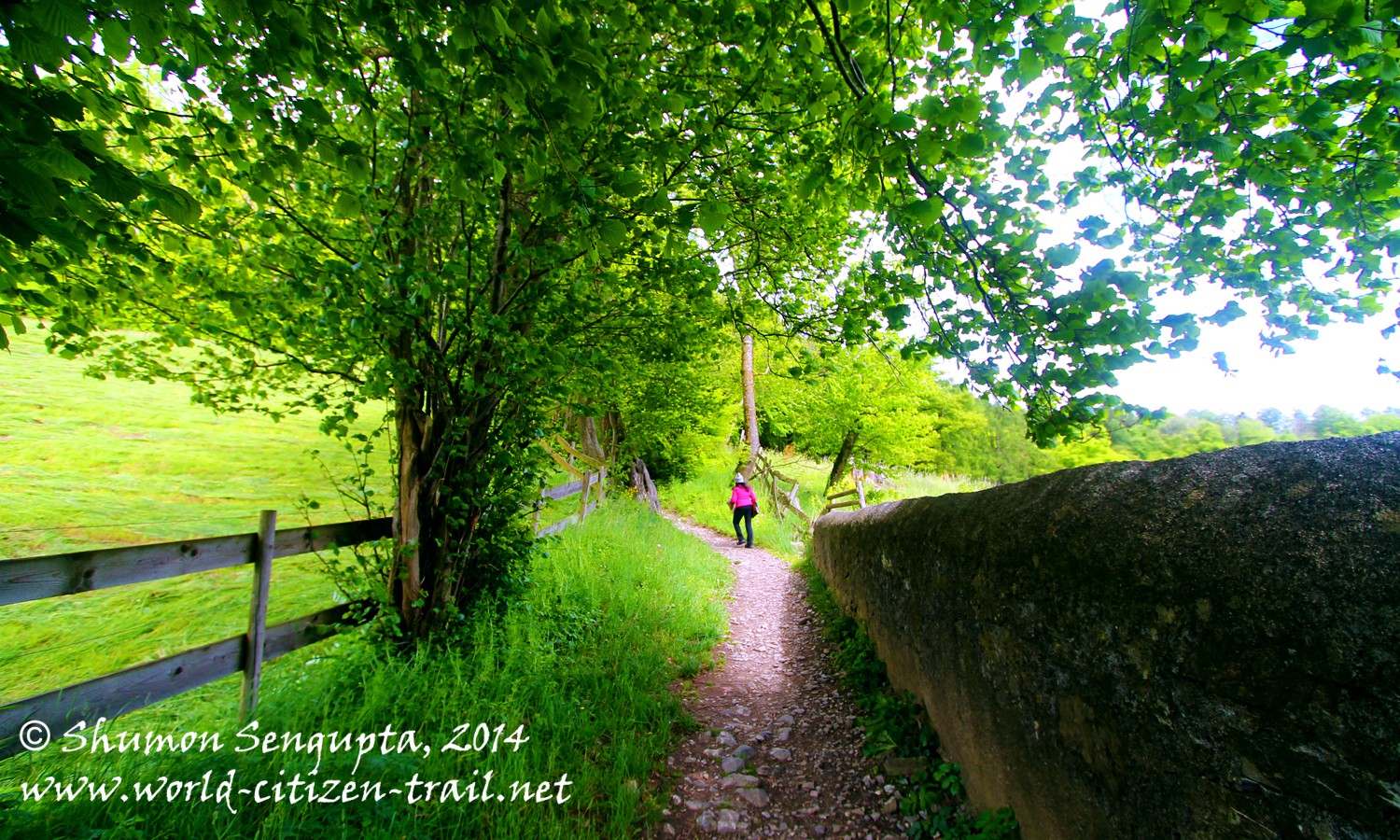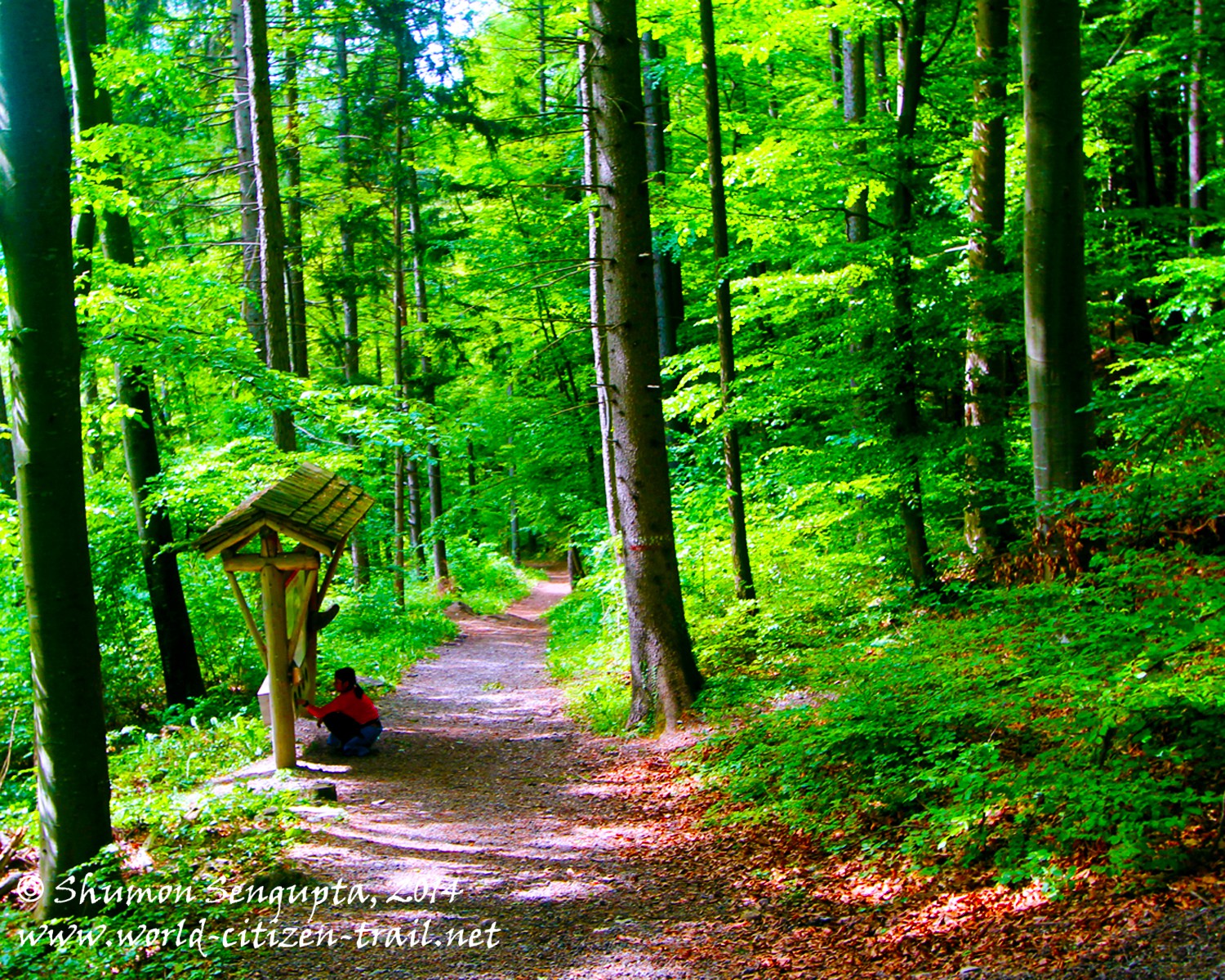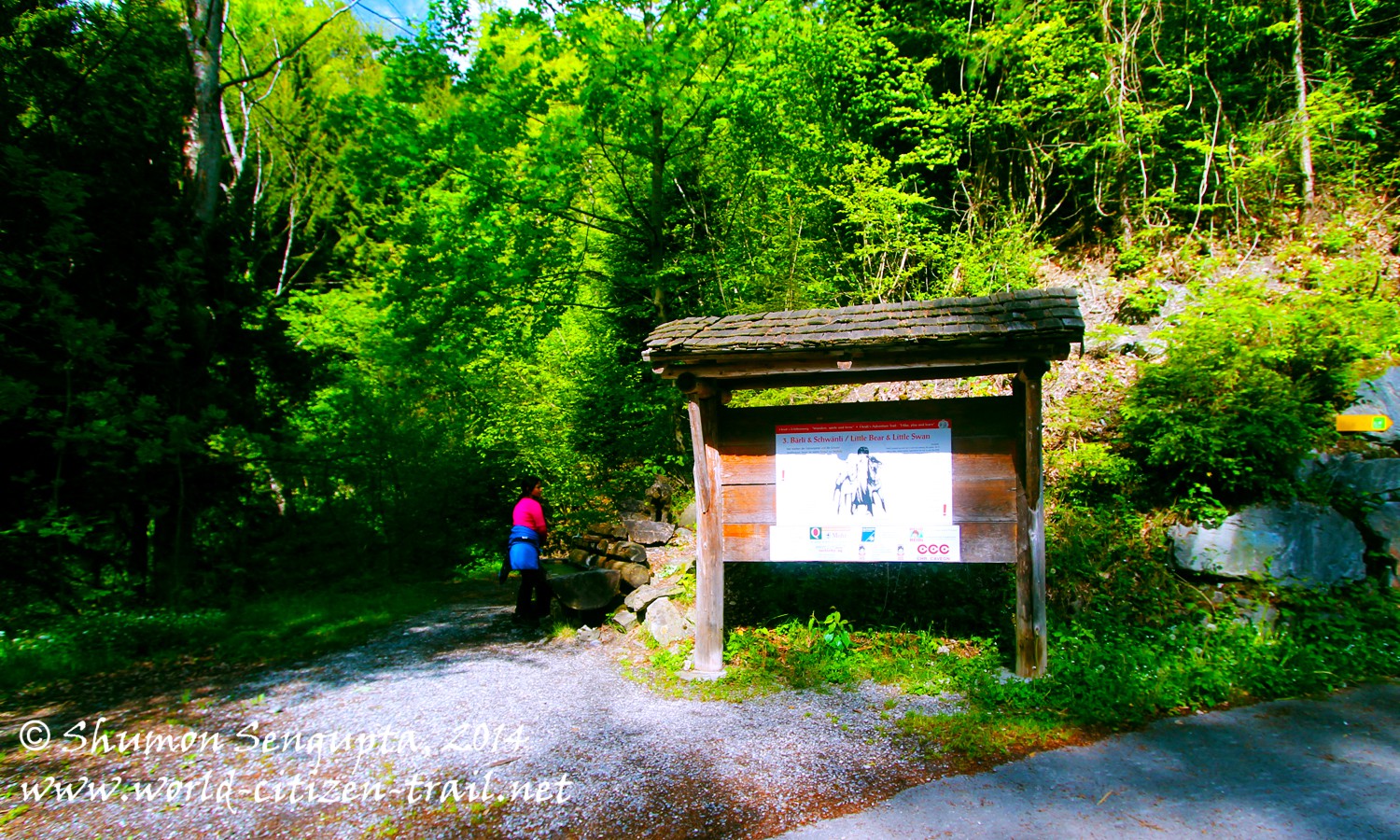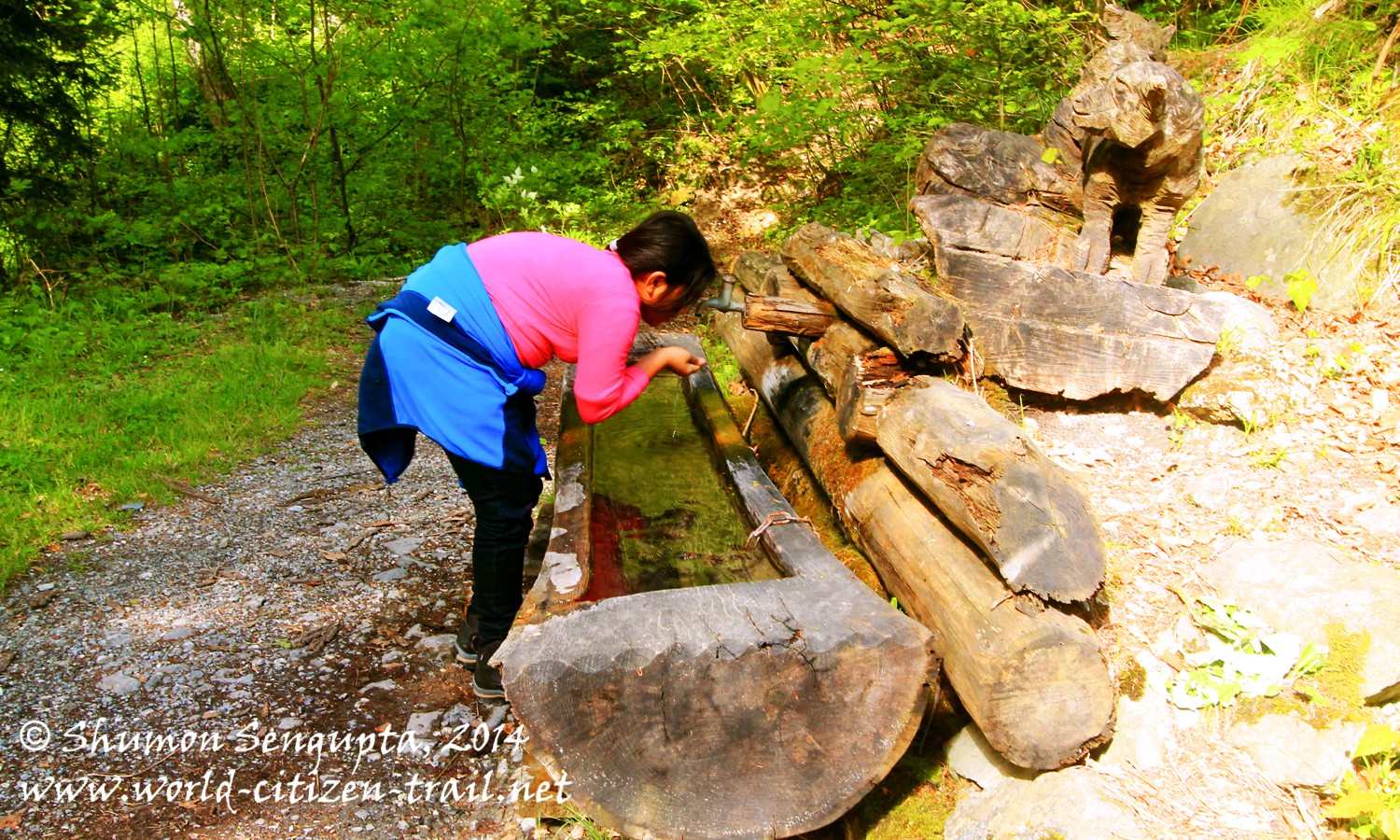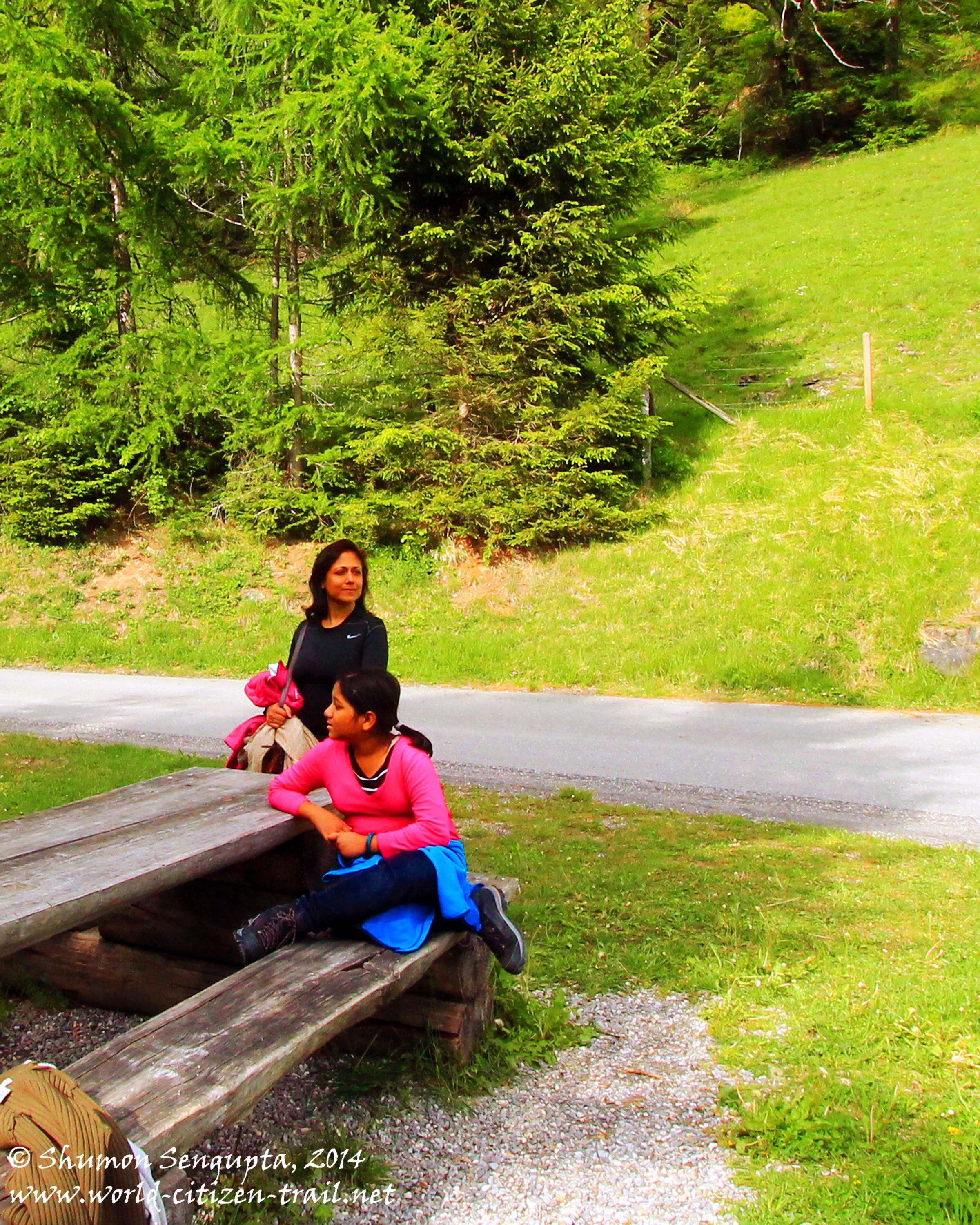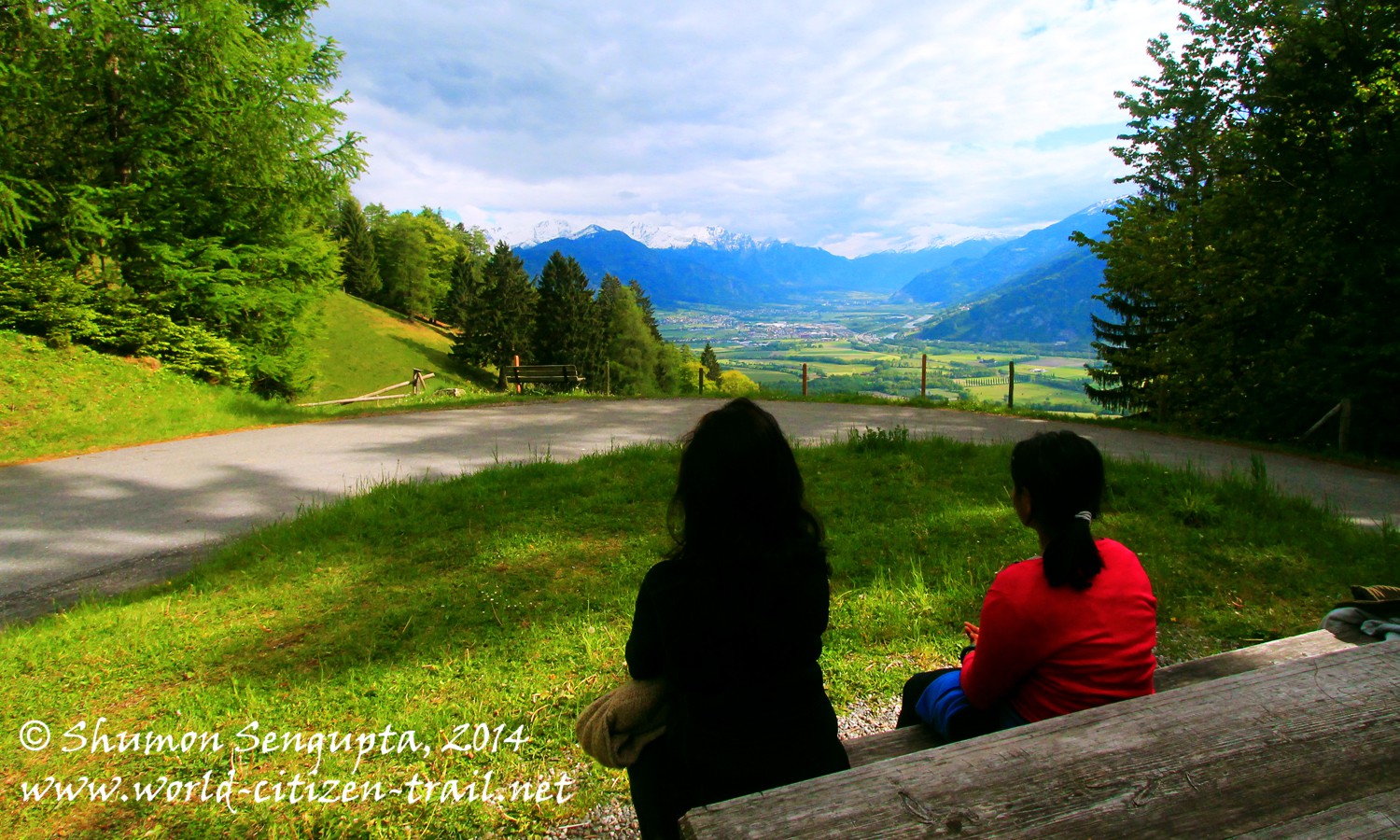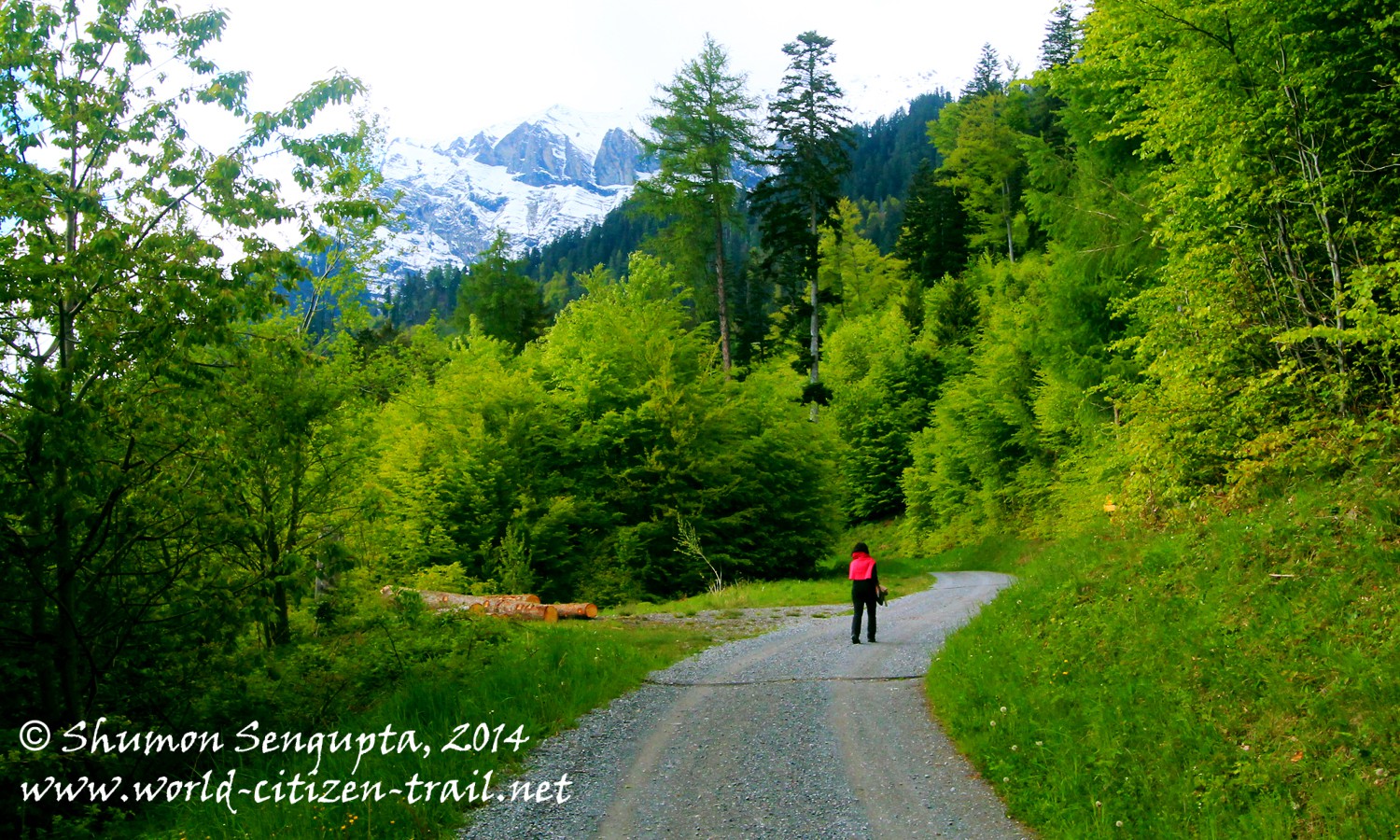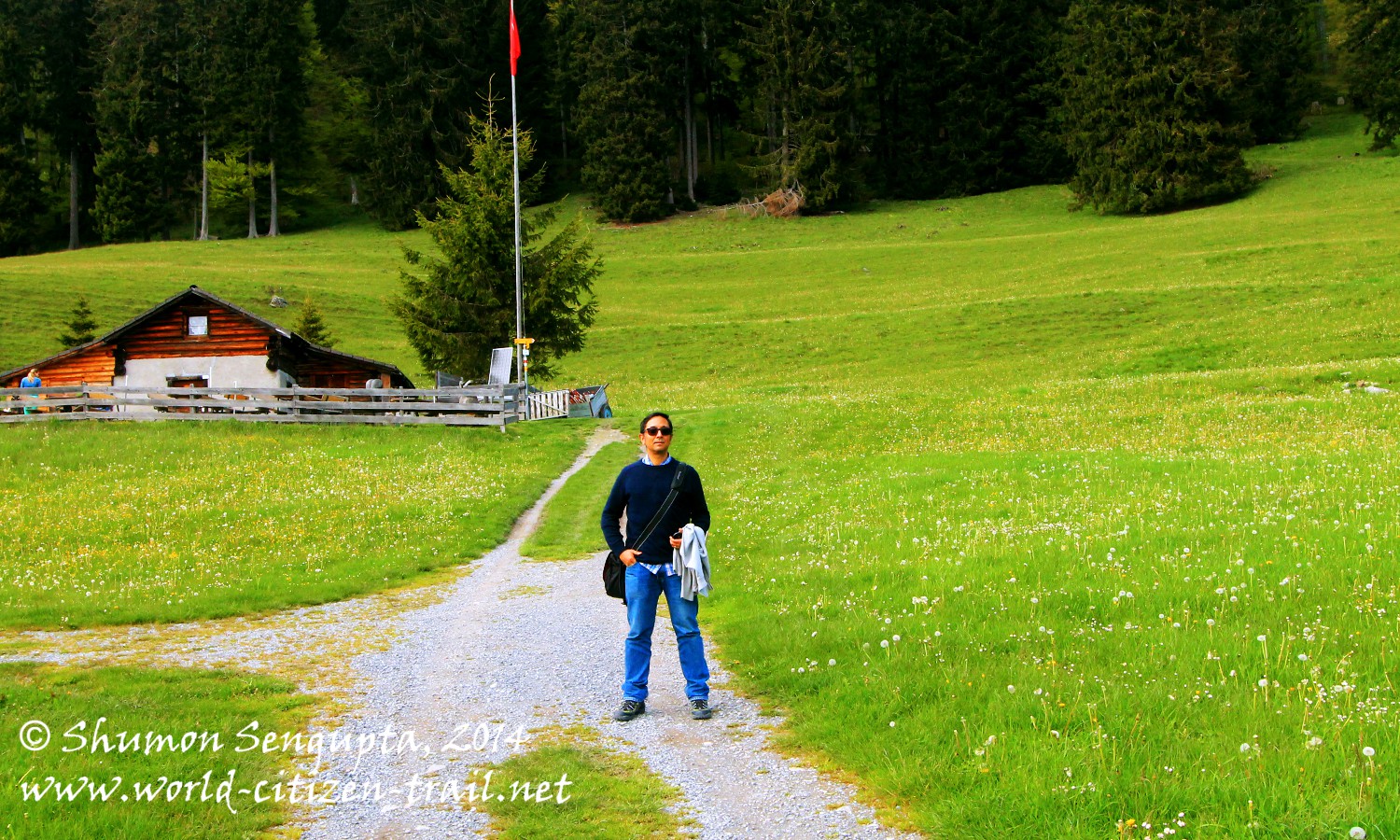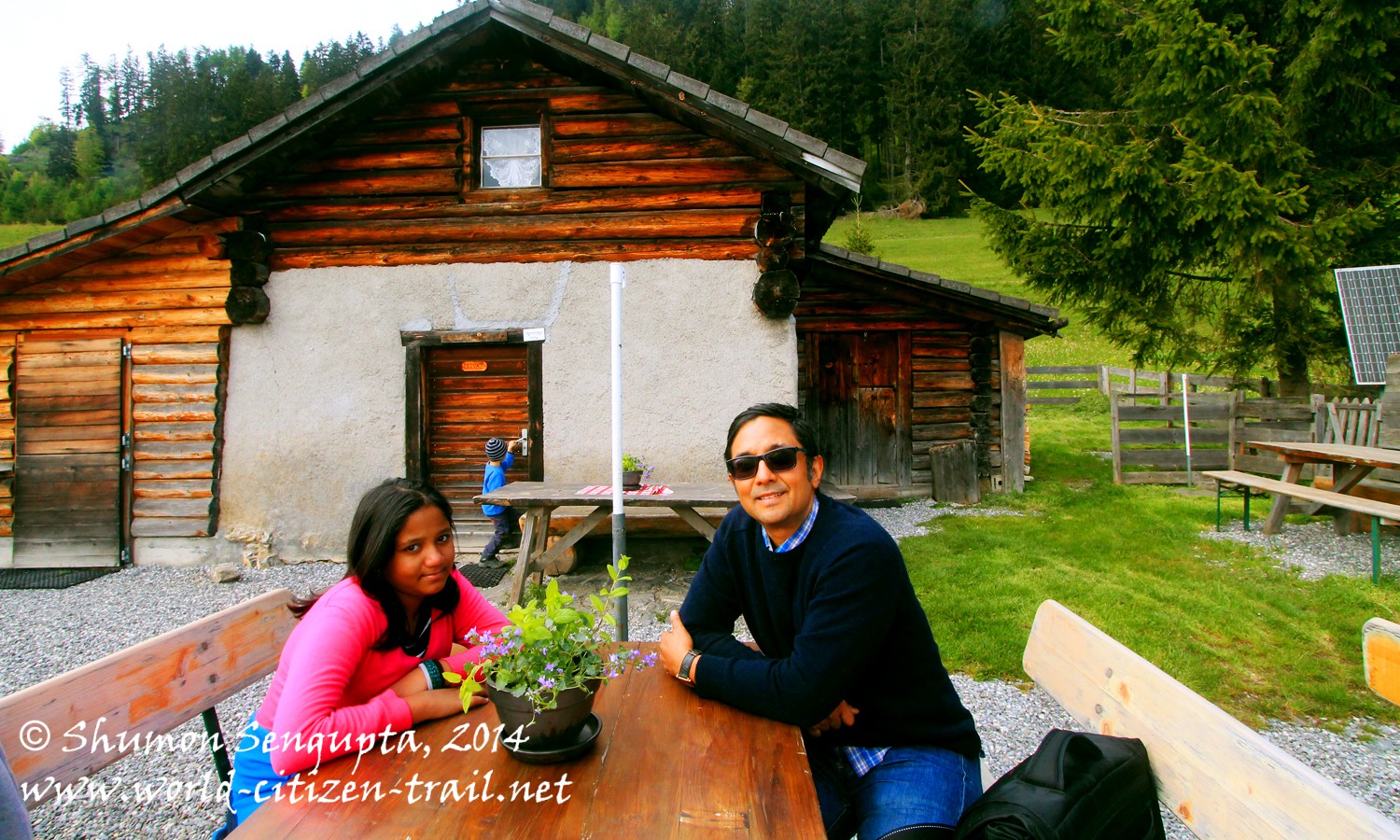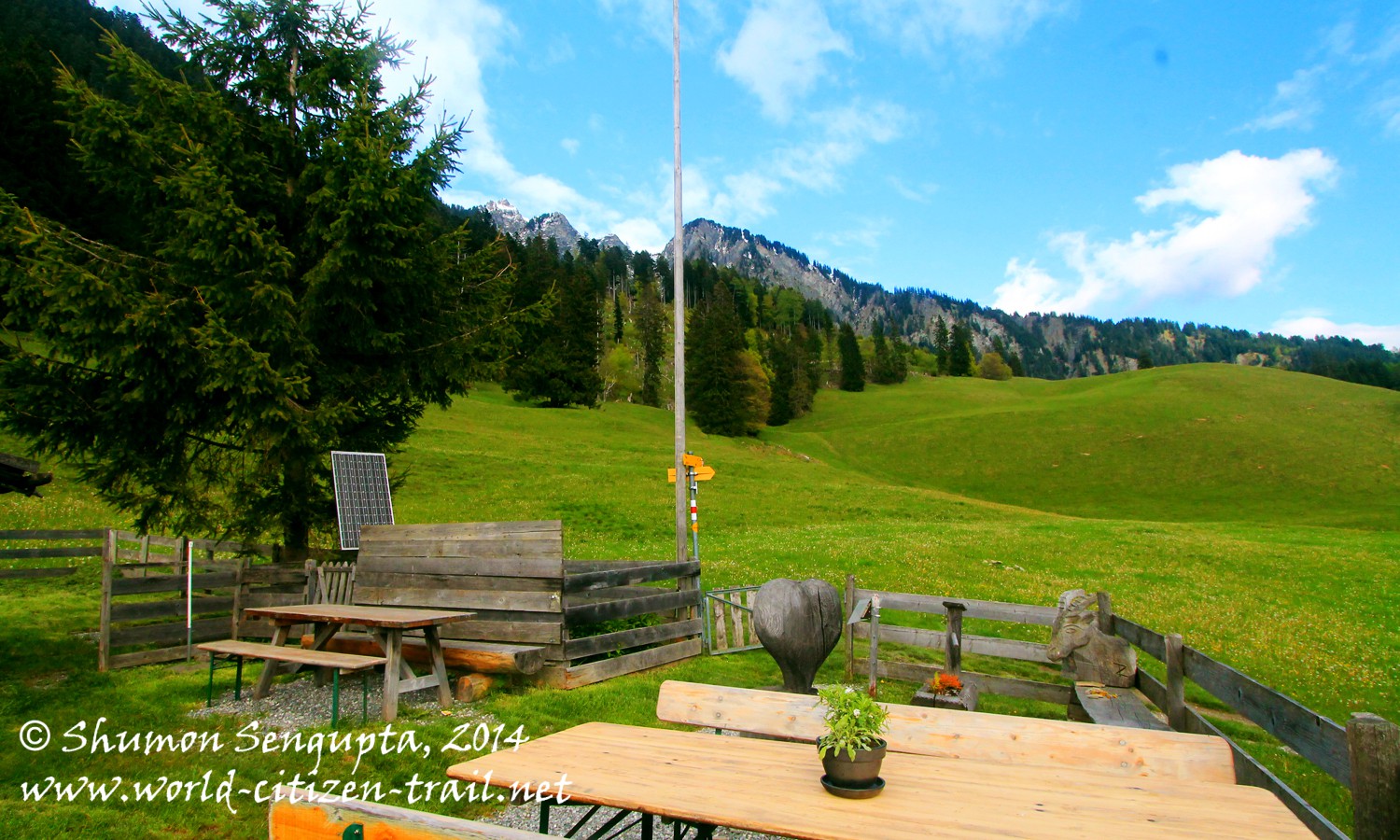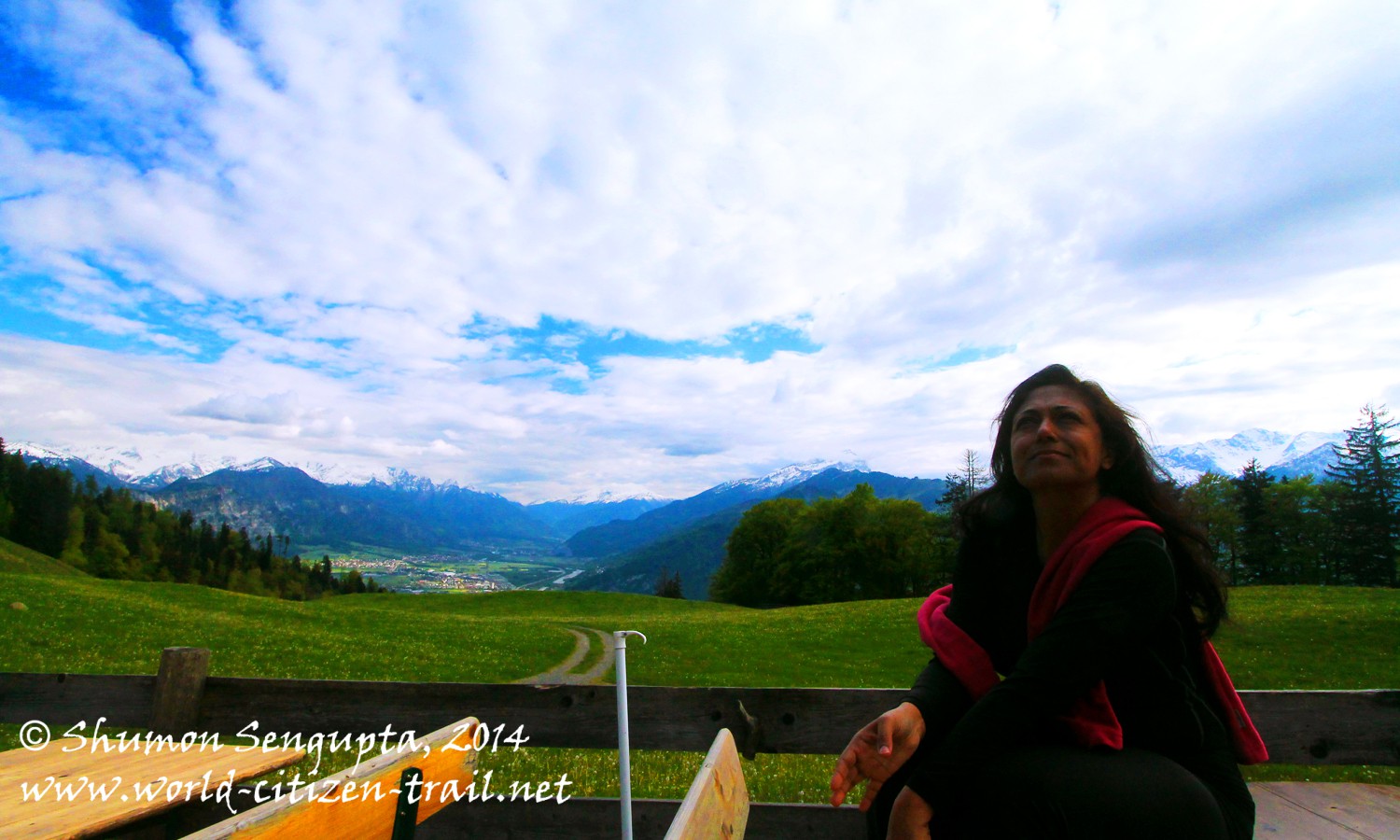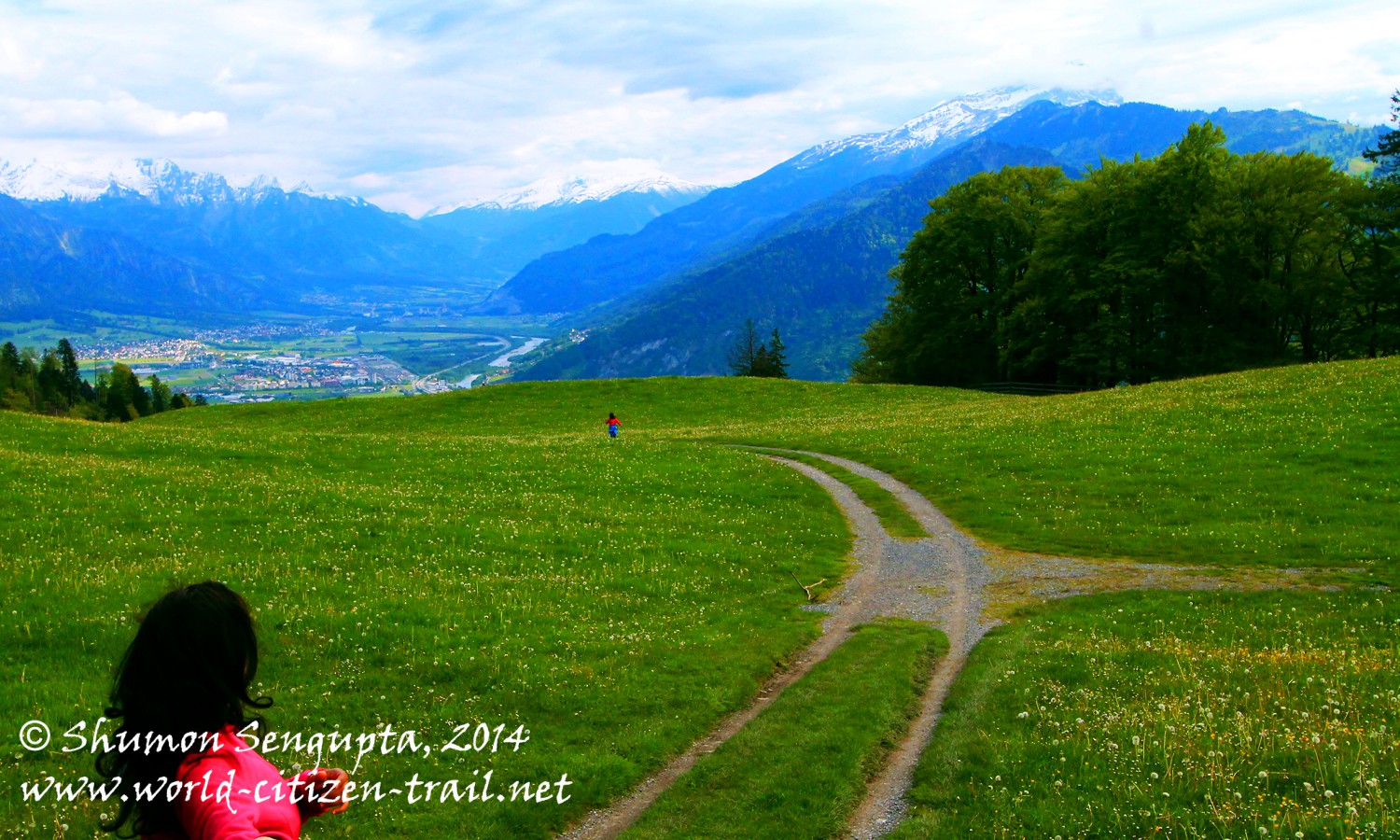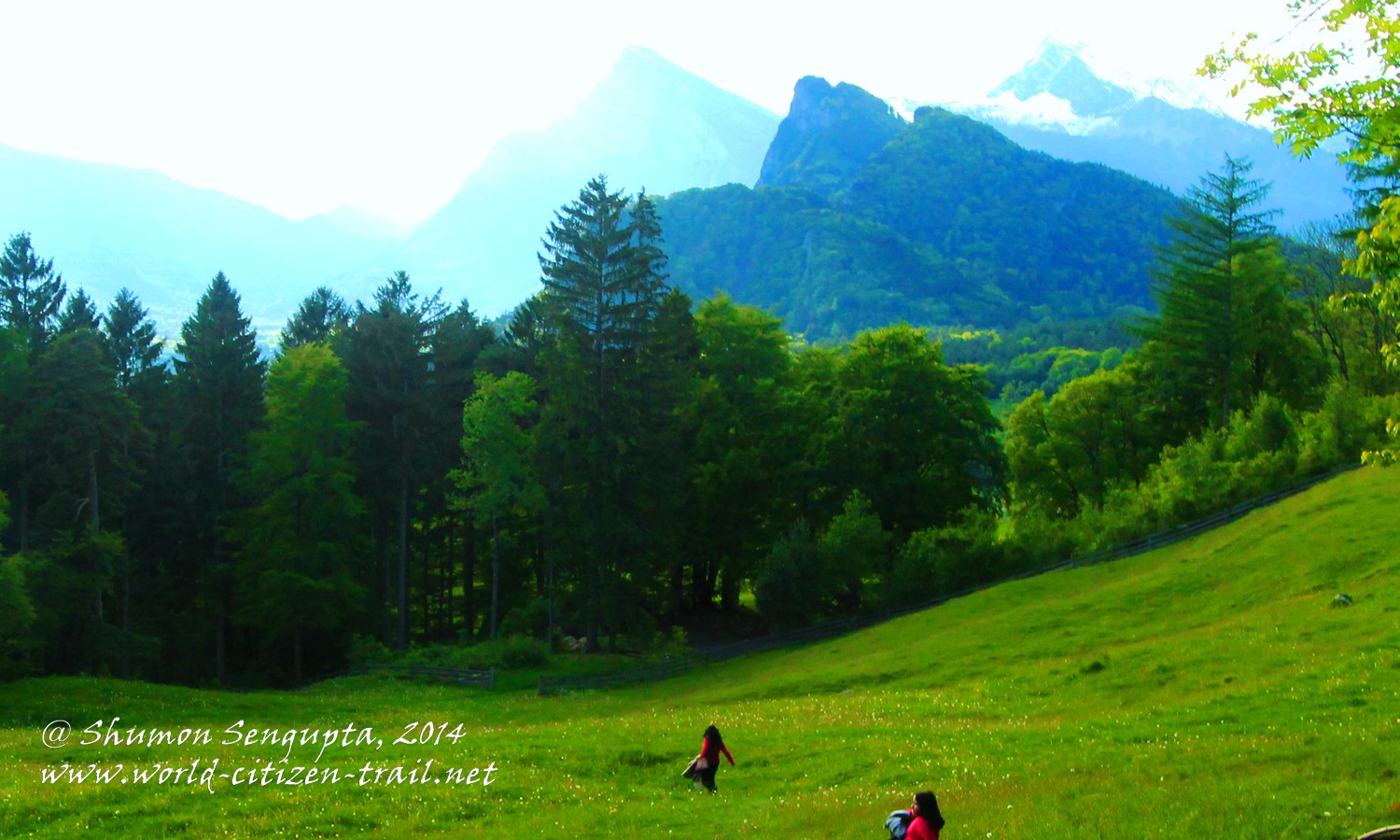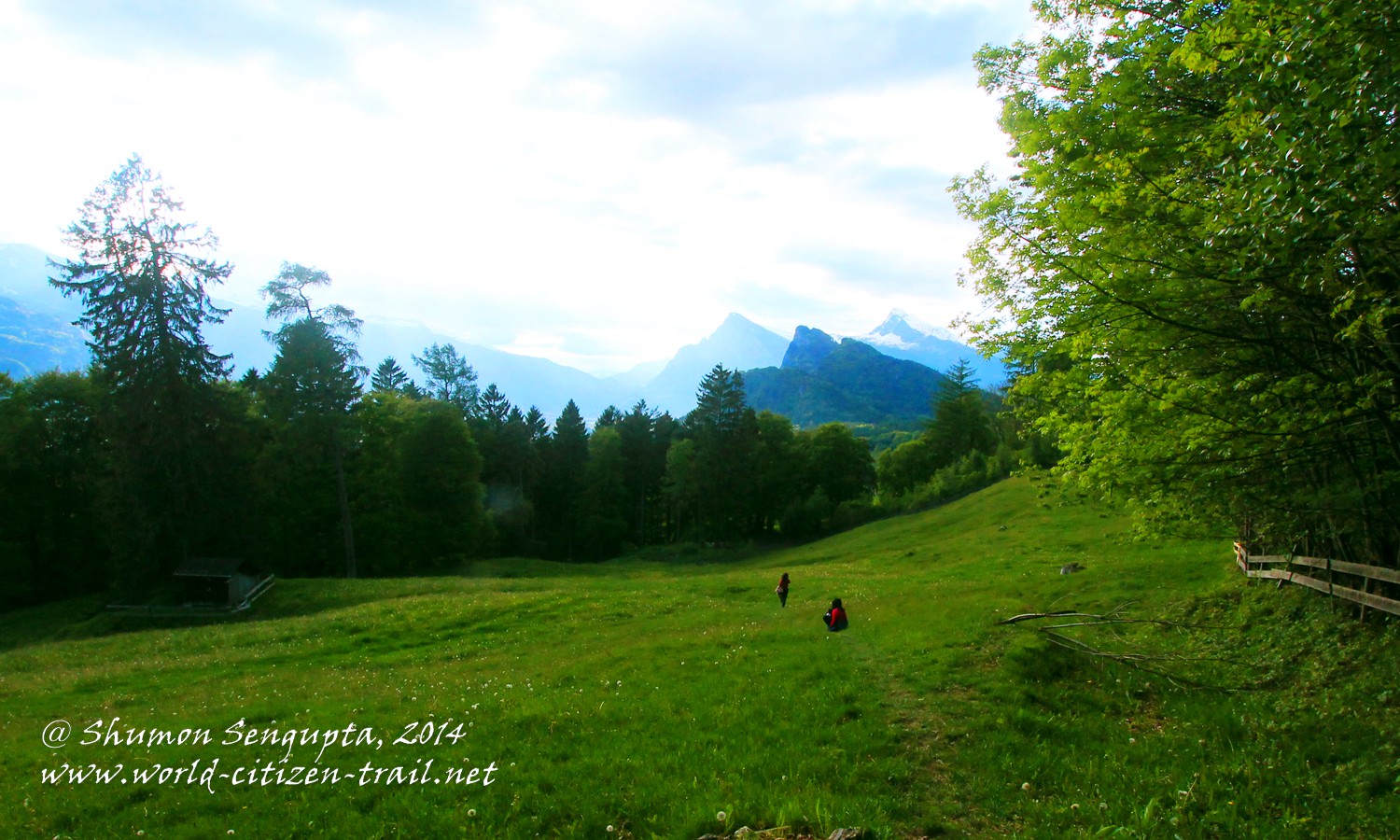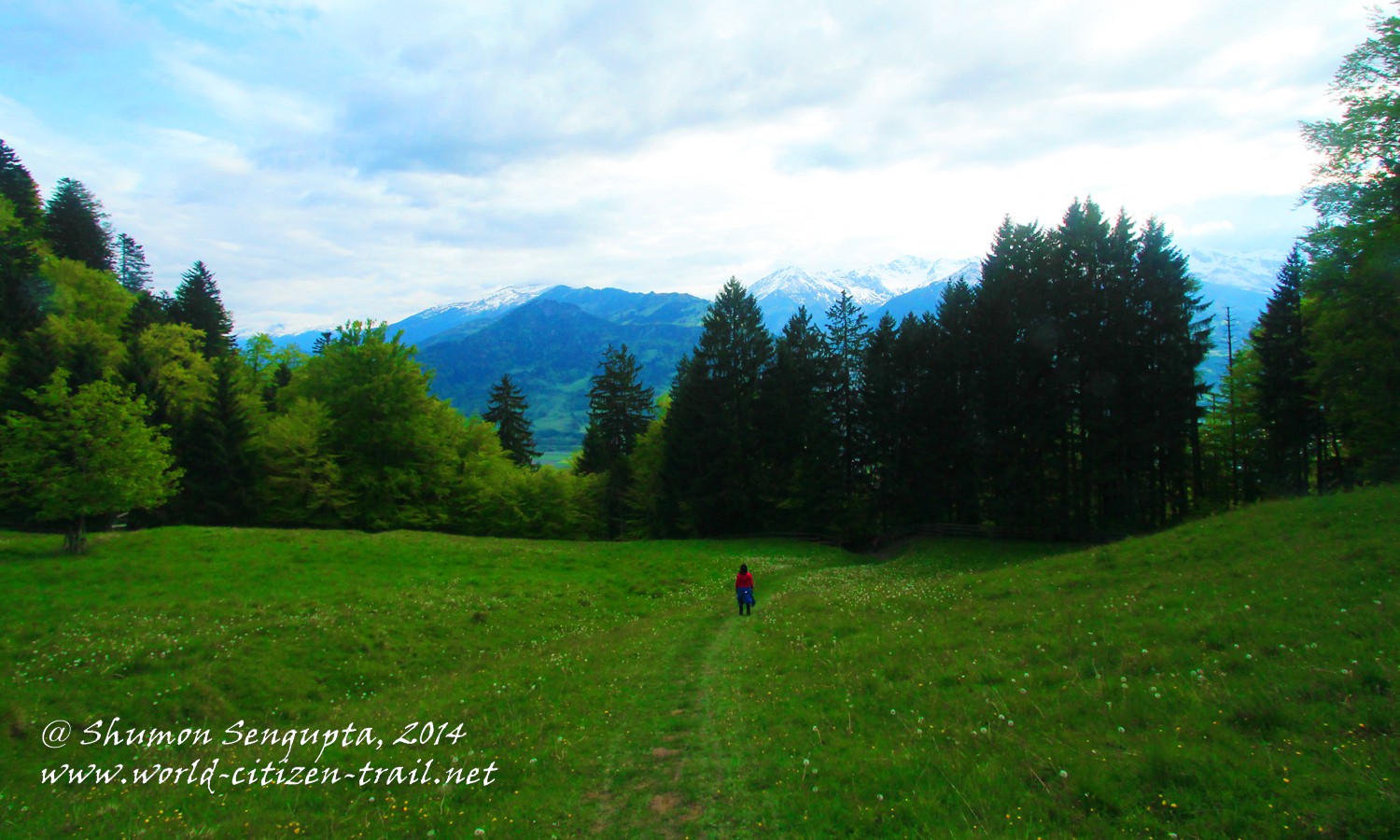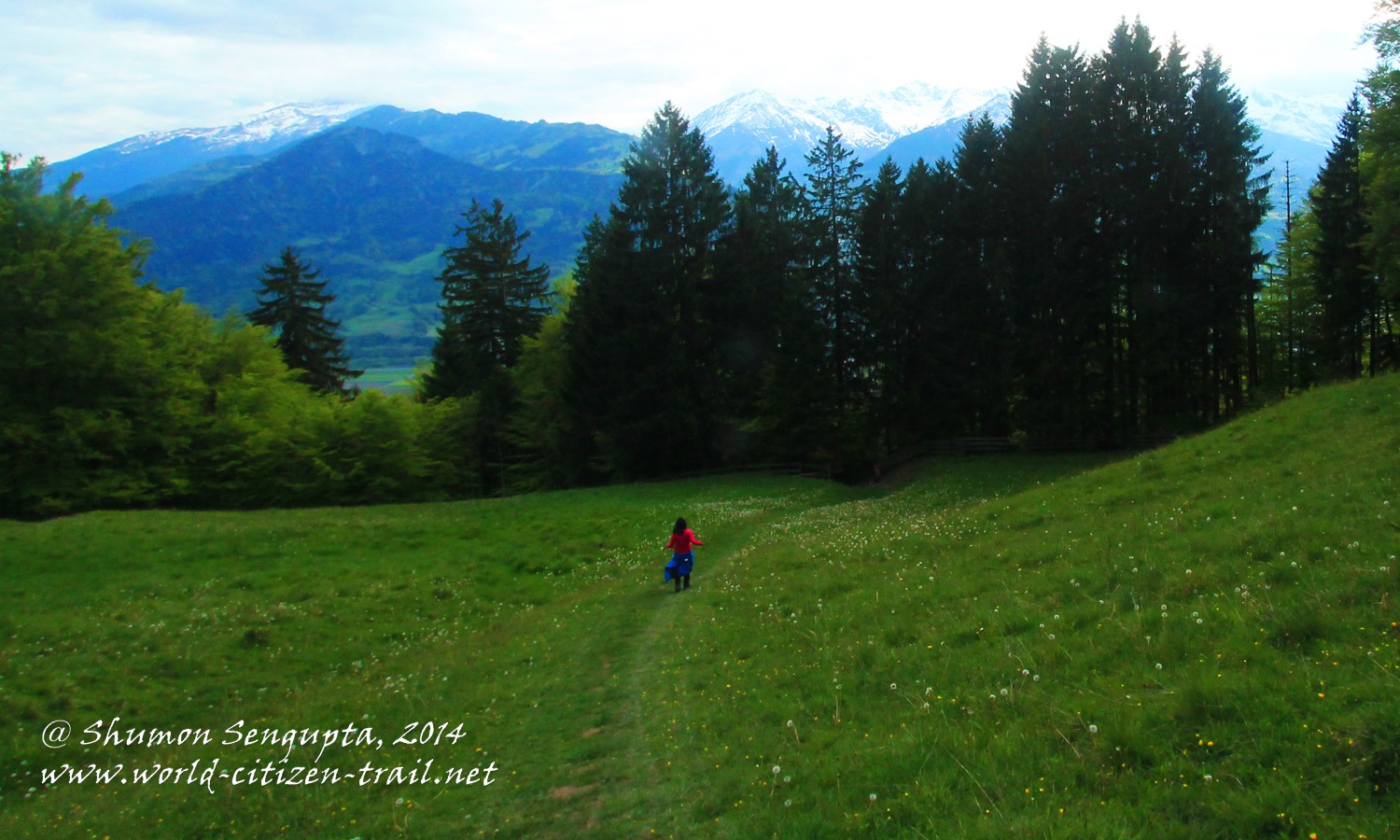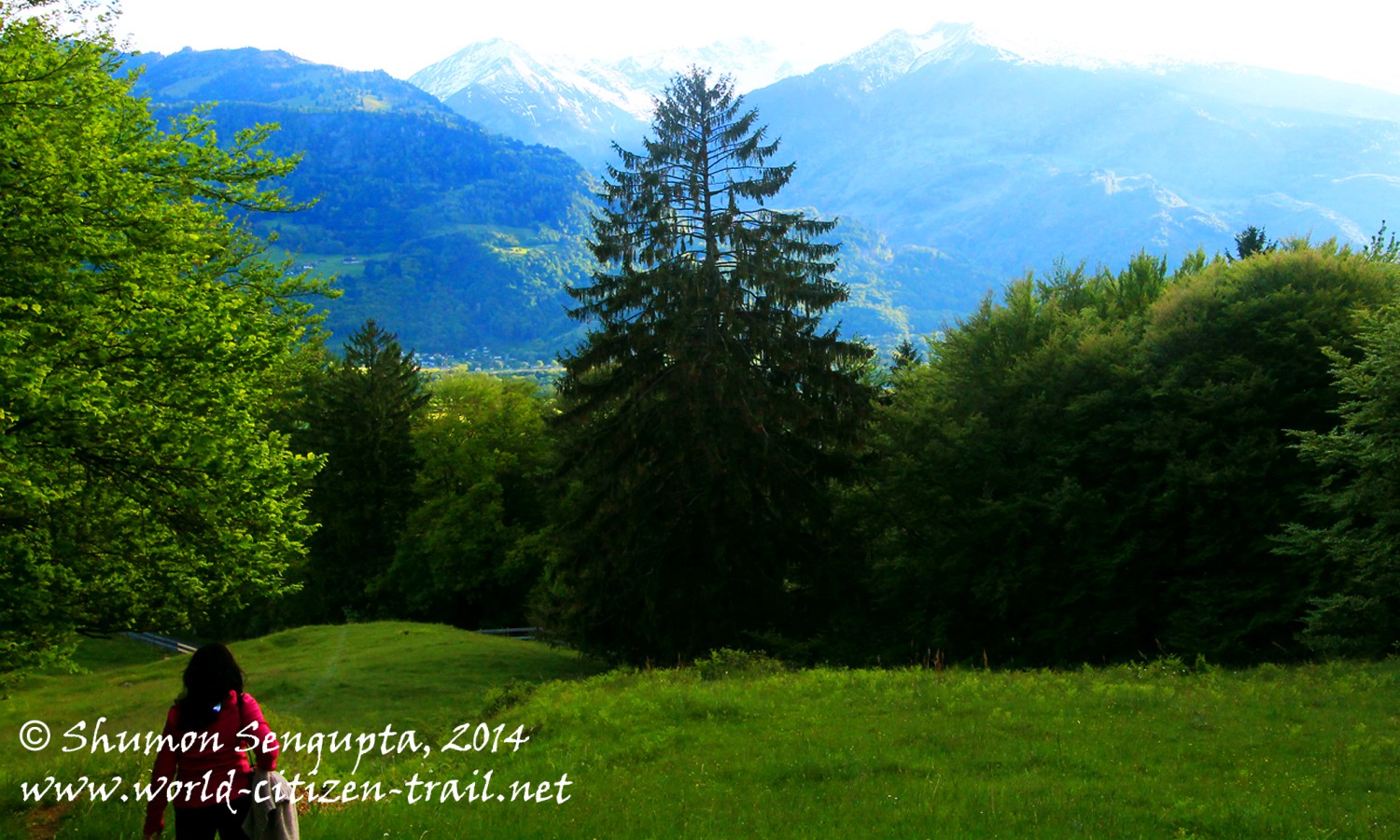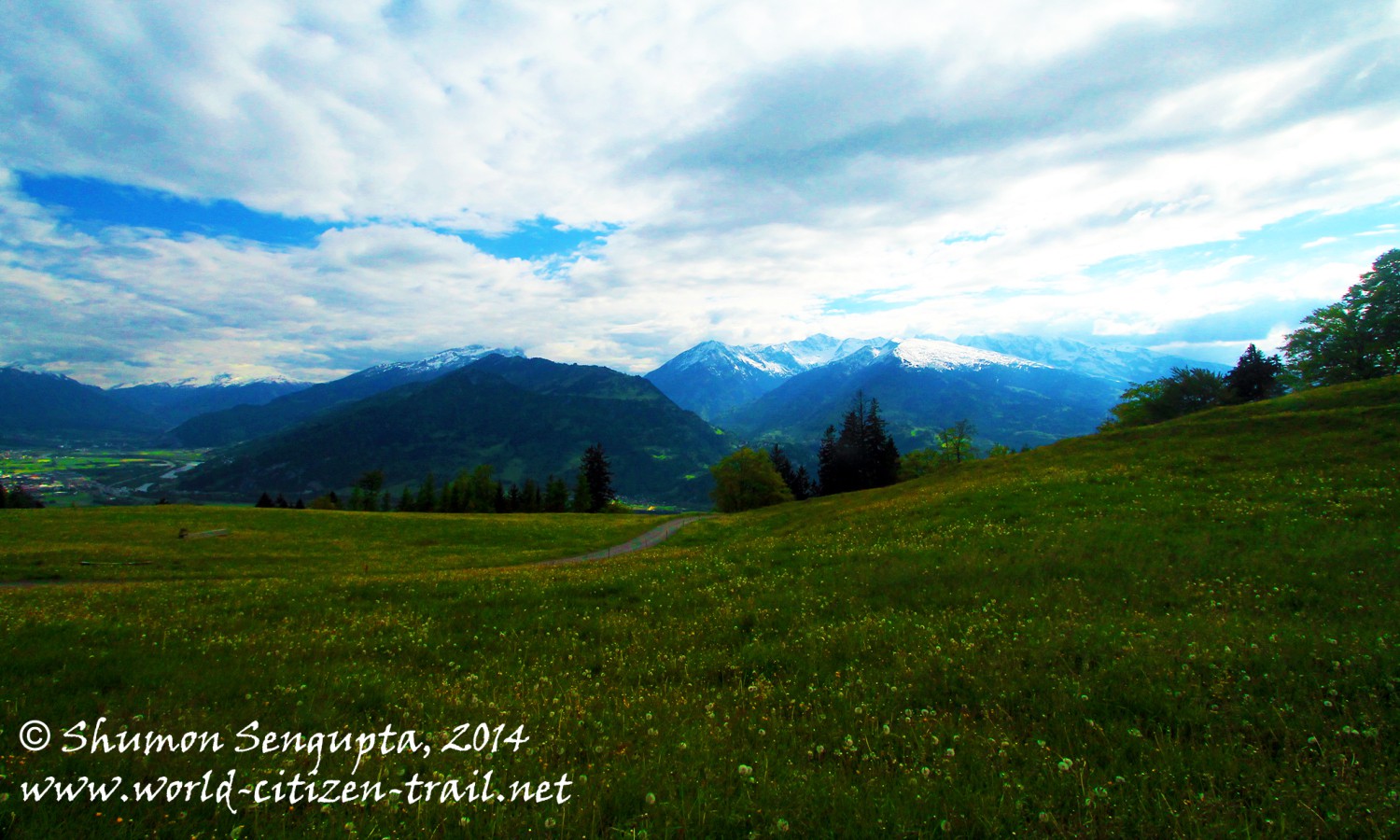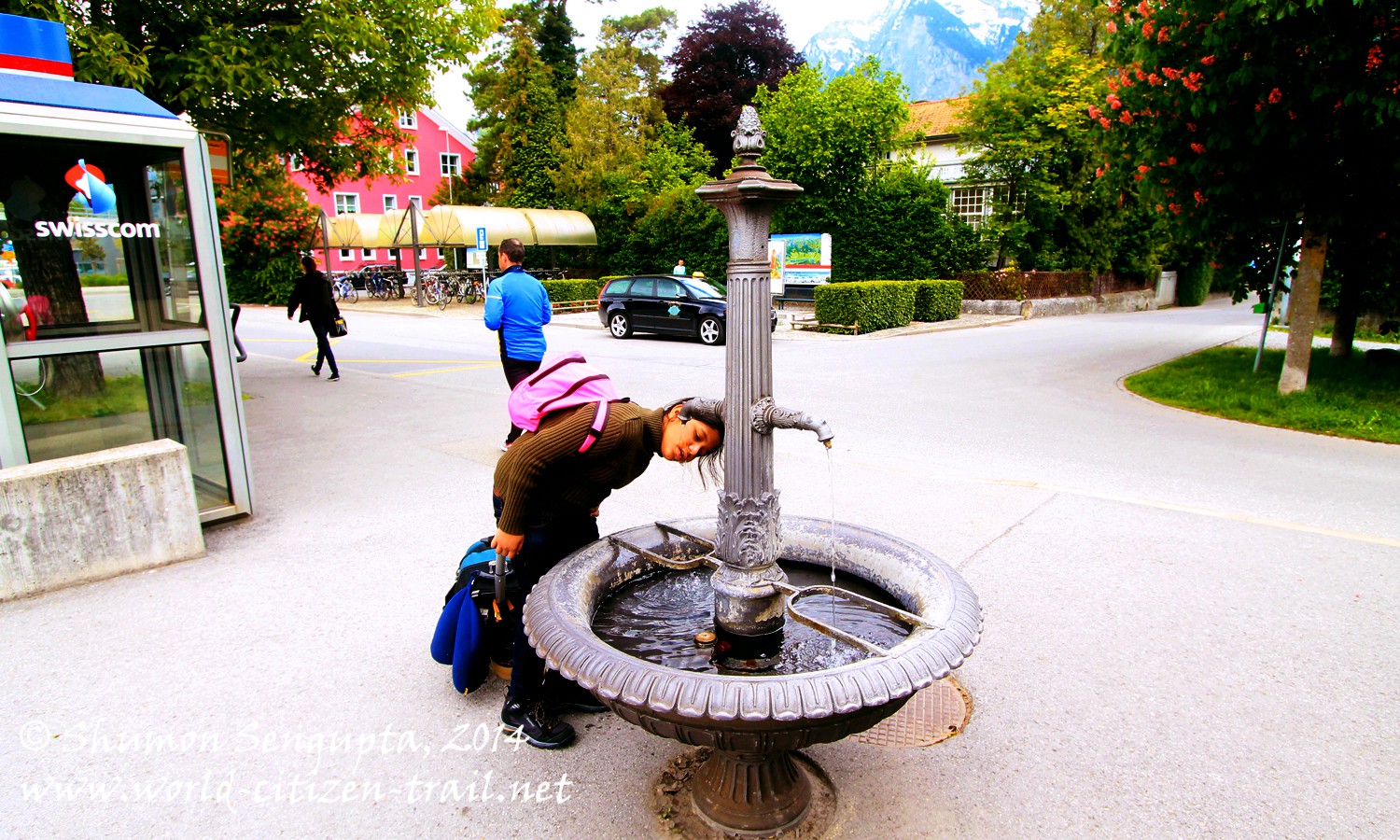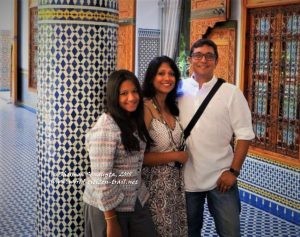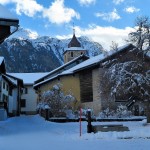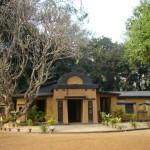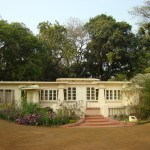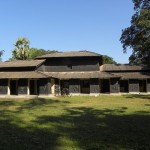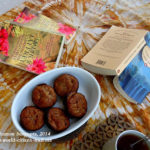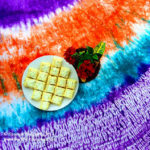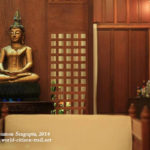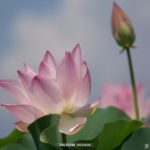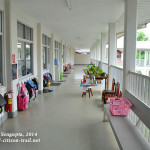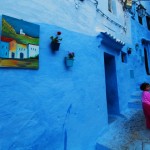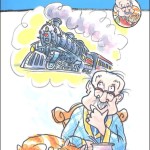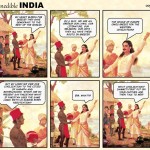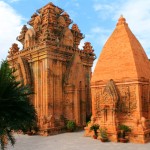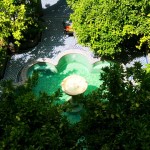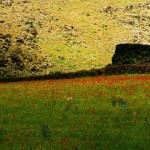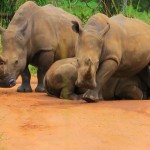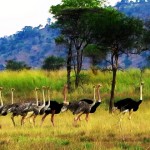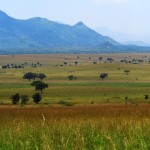One of the highlights of our holiday in Switzerland was a trip to Maienfeld, a place that had provided the picturesque setting for Johanna Spyri’s (1827-1901) celebrated and much loved children’s classic, Heidi. Published in 1880, translated into over 50 major languages of the world and cinematized in motion picture and animation, this book has, since its publication, represented the image of idyllic Switzerland in popular imagination.
Our trip to Maienfeld was planned as a surprise for our 11 year old daughter, Minnie, who had read and loved the story of Heidi as much as we had. We had created mental images of this place based on the vivid descriptions provided in the book and wanted to see it for real.
Situated at an elevation of 502 meters, the town of Maienfeld lies on the eastern side of the Rhine Valley, at the foot of the Falkins Mountains. It is located in the best known wine producing (Blauburgunder in particular) region in the canton of Graubunden. This charming old town also once stood at a strategic point in the Rhine Valley, along a historic trade and military route, the architectural vestiges of which can been seen even today in the form of castles of Salenegg and Brandis and few old mansions.
From Zurich, Maienfeld is a 90 minute train journey. Since we were in Appenzell the previous day, we left from there (from the Wasserauen train station) early in the morning and arrived in Maienfeld late in the morning, with changes of trains in Gossau and Bad Ragaz. The train journey took us 2 hours 14 minutes.
Today, the town of Maienfeld is considered to be the center of what has come to be known in popular tourism as “Heidiland” (courtesy Spyri’s book). Also, a tiny hamlet on the slopes above Maienfeld, next to the village of Oberrofels has been renamed as the make-belief “Heididorf” or Heidi’s Village. This is where Heidi and her Grandfather spent the winters in their village house, in the story. And the alpine meadow (Ochsenberg), where Heidi and her Grandfather spent the summer in a mountain hut, grazing their goats in the high alpine pastures, has been renamed as “Heidi Alp”.
Those of you who have read the novel will recollect that there are three key locations for the novel. Apart from the “winter house” in the village (above Maienfeld) and the “summer mountain hut” high up on the mountain pasture, an important section of the story is set in Frankfurt, where Heidi spent some time as a companion to a partially disabled girl Carla, in the latter’s desolate and joyless family mansion.
For Heidi enthusiasts and Johanna Spyri fans, a well marked and easily negotiable “Heidi Trail” starts from the railway station in Maienfeld. It goes past the Schloss Brandis castle and meanders through the narrow lanes of the old town towards its higher reaches. From the edge of the town, the path then passes through vineyards, through the village of Rofels, to hamlet of “Heididorf” and then on to the “Heidi Alp” in the high mountain pasture. It follows the route Heidi and her aunt had taken in the novel, to meet her grandfather for the first time.
Because we had less than a full day here, we decided to skip the town and head straight by Postbus from Maienfeld to Oberrofels (next to “Heididorf”).
In late spring / summer in Switzerland, a stay in a farm house (which also often means sleeping in the hay) provides a wonderful experience enjoyed by children and adults alike. In Oberrofels, we checked into a farmhouse by the name Hof Just (pronounced Hof-Yusht), owned by Max and Dorli Just. Dorli, our incredibly hard working hostess seemed to manage the farmhouse almost single handed. She was very professional, as she was friendly, kind and helpful. And she dished out some amazing fondue, bread, milk, butter, cheese, farm fresh salads and meringue (with fresh whipped cream) for us. We also got to see the farm and feed the docile and incredibly loveable cows.
After checking in, we headed off to “Heididorf” – a small hamlet recreated to resemble the hamlet Johanna Spyri had described in her book. At “Heididorf”, we visited “Heidi House”, once again recreated to the minutest detail based on descriptions found in the fictional novel. There was a CHF 6 entry fee.
This old-world stone and wood house had recreated life from the period in which the story was set. Carpentry tools, furniture, kitchen utensils, cloths and footwear from that period (exactly as Heidi and her grandfather would have used / worn had they been historical characters) are found inside the house. We also found the archaic wooden wheelchair used by Clara, another child character in the story. And then we climbed up to Heidi’s bedroom in the attic – the view from the little window in Heidi’s room was spectacular, just as it is described in the novel.
Visiting this house was like entering the pages of Spyri’s fictional novel. Apart from Heidi’s house itself, the goat barn, the poultry pen, the Heidi Fountain and village souvenir shop had also been recreated, exactly as per the novel. And there was a Museum about the author, in addition to a post office that had special “Heididorf” stamps.
There were other houses, including the Rathaus (or community hall) in the hamlet, all built in the traditional old style, with stone and wood. The hamlet was surrounded by pastures, firs, pines, and pear, berry and apple trees. And there were cows and goats with their bells clanging as they lazily munched away grass. The day was clear, sunny and sparkling, the air redolent with the fragrance of pines, freshly cut grass and alpine blossoms; the silence occasionally rent with the melodious sounds of cow bells. The scenery all around was idyllic and dreamy, as much as it was magnificent, fringed by the soaring Falkins Mountains.
For us, a trip to this place was not going to be complete without a hike up to “Heidi Alp” (real name – Ochsenberg, at 1,111 meters) and we soon hit the long uphill trail. This adventure trail led from “Heididorf”, all the way up to the high meadow, ending in a small mountain hut which housed a small café. We planned to have a snack once at the top, to recharge ourselves after the long hike.
From the “Heidi House” in “Heididorf”, we took the longer trail to “Heidi Alp”. At the edge of “Heididorf”, we passed through the Luva forest and then further up, a desolate chalet named “Peter’s the Goatherd’s House”. All along the way, starting from “Heidi Dorf” to “Heidi Alp”, there were 12 stations/stands that described important locations, incidences or descriptions from the story, through short narratives, pictures, sculptures and brief activities.
It took us over two hours to reach the high meadow, mainly because we took it easy and stopped at various points. By all means it was a strenuous hike, but the scenery was worth it, particularly at the top, at the end of the trail.
After reaching “Heidi Alp”, much to our disappointment, we found the café at the Mountain Hut closed. We rested for some time and took in the views, which were breathtakingly spectacular. It was a magical place where vast expanses of thickly carpeted lush green alpine meadows were framed by majestic snow capped mountains. Time stood still and amidst such solitude, profound peace and boundless splendor, we experienced the sense of the infinite.
By then, the sun had gone down, but it was still bright. We returned downhill through a shorter meandering trail through the woods and lush meadows filled with alpine wildflowers. Somewhere on the way, we missed the trail and got lost. However, we did eventually find our way back, through the village of Jenins, into “Heididorf”, after having jumped fences and trespassed through private property with impunity.
We had a hearty dinner of garden fresh salad and Rosti, a local specialty made of deep fried partially boiled potato, loaded with cheese and topped up with fired eggs / sausage at the local Heidihof Restaurant. We then went back to Max and Dorli’s farmhouse, where we had some delicious Meringue with whipped double cream for dessert.
Before hitting the bed, rather the hay, we had a warm shower in the common bathrooms located below the level where the hay is stacked. And then that night, we had one of the most incredible experiences from our 25 day trip of Switzerland. We slept like logs in the warm hay (clean sheets, blankets and pillows were provided), huddled together.
The next morning, although Dorli had prepared our breakfast on time, we were running a bit late. Since taxis were not available so early in the morning, we had planned to take the Postbus back to Maienfeld train station. Because we were running short of time, Dorli very kindly offered to drive us back to the Maienfeld train station so that we could board the local train at 7.43 am and reach Chur on time to take the Bernina Express at 8.32am for Lugano. She graciously declined a payment when I offered it.
Genuine kindness often comes your way, when you least expect it, I thought.
To us, during this entire trip, particularly during hike on the “Heidi Trail”, the story of little Heidi – the delightful orphan girl, the free spirited child of nature came alive, as did that of other characters of the story. In addition, we also sensed the very spirit of the times in the idyllic 19th century Swiss mountain land, when the story was written. For us, it was difficult to tell, where fiction ended and the fact begun, Spyri’s words rung so true.
In the story, contrasted with the claustrophobic urban conditions encountered in Frankfurt, Heidi feels a sense of abandon, of freedom and security, living in the Alps, with her grandfather; in the company of goats and her friend Peter (the goatherd) and his family. It is here that Heidi discovers the unbounded joys of living each day, of a simple, harsh but beautiful life, spent in the glorious lap of nature.
Our trip to “Heidiland” took us back on a journey into the Swiss mountain world of the late 19th century. The innocence of childhood, the sights, sounds, smells and adventures from a time long gone, albeit fictional, came alive for us. It felt as if the pages of Spyri’s exceedingly beautiful and evocative story, the very spirit of the work had come alive for us.
And even today, more than a century from the fictional Heidi’s times, very much like Heidi, we were left soothed and comforted by the landscape of high mountains, the tranquil vistas of sprawling alpine meadows, small sleepy villages and images of an idyllic lifestyle.
Spyri’s fictional story touches a deep chord within us when we see the reflection of joy, of freedom, harmony and purity of nature in the image of a happy, free spirited little orphan girl. We see the “reflection of the infinite within the finite”*.
End note:
The renaming of the region around Maienfeld as “Heidiland”, the hamlet near the village of Oberrofels as “Heididorf” and the alpine meadow of Ochsenberg as “Heidialp” has been criticized by some as being “cruel”, a “laughable, infantile cliche” and “a more vivid example of hyper-reality”.
All is well for the critics. And all is also well for children and those of us adults who still harbor a little child somewhere deep within us. For us, “Heidiland” is a place where the boundary between fiction and fact gets blurred, where we are left with nothing but delight and joy, the sense of freedom in nature and in liberating make-belief.
“Heidiland” – the idea thereof – is a beautiful and heartwarming case of life imitating art – a justification in itself.
*to borrow a phrase from Indian Poet Laureate, Rabindranath Tagore.
